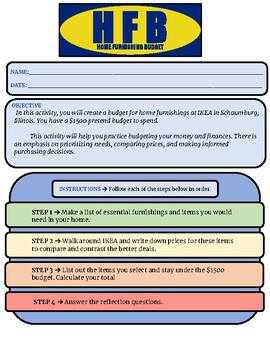Home Furnishing Budgeting Project Worksheet - Life Skills
Common Creations and Curriculum
21 Followers
Grade Levels
4th - 12th, Adult Education, Homeschool
Subjects
Resource Type
Standards
CCSS4.NBT.A.2
CCSS4.NBT.A.3
CCSS4.NBT.B.4
CCSSCCRA.L.4
CCSSMP2
Formats Included
- PDF
Pages
4 pages
Common Creations and Curriculum
21 Followers
Also included in
- Transform your students' understanding of budgeting and home economics with this comprehensive lesson plan designed to bring real-world application into the classroom! The "Home Furnishing Budget" takes students on an exciting field trip to IKEA (virtually OR in person) and has them explore essentiaPrice $4.99Original Price $10.97Save $5.98
Description
Head to a local furniture store - like IKEA - and use your pretend $1500 budget to furnish your home. Practice budgeting! Explore the difference between NEEDS and WANTS. Learn how to make savvy purchasing decisions.
Total Pages
4 pages
Answer Key
Does not apply
Teaching Duration
3 hours
Report this resource to TPT
Reported resources will be reviewed by our team. Report this resource to let us know if this resource violates TPT’s content guidelines.
Standards
to see state-specific standards (only available in the US).
CCSS4.NBT.A.2
Read and write multi-digit whole numbers using base-ten numerals, number names, and expanded form. Compare two multi-digit numbers based on meanings of the digits in each place, using >, =, and < symbols to record the results of comparisons.
CCSS4.NBT.A.3
Use place value understanding to round multi-digit whole numbers to any place.
CCSS4.NBT.B.4
Fluently add and subtract multi-digit whole numbers using the standard algorithm.
CCSSCCRA.L.4
Determine or clarify the meaning of unknown and multiple-meaning words and phrases by using context clues, analyzing meaningful word parts, and consulting general and specialized reference materials, as appropriate.
CCSSMP2
Reason abstractly and quantitatively. Mathematically proficient students make sense of quantities and their relationships in problem situations. They bring two complementary abilities to bear on problems involving quantitative relationships: the ability to decontextualize-to abstract a given situation and represent it symbolically and manipulate the representing symbols as if they have a life of their own, without necessarily attending to their referents-and the ability to contextualize, to pause as needed during the manipulation process in order to probe into the referents for the symbols involved. Quantitative reasoning entails habits of creating a coherent representation of the problem at hand; considering the units involved; attending to the meaning of quantities, not just how to compute them; and knowing and flexibly using different properties of operations and objects.






